小学英语?阅读 一、考题回顾二、考题解析 【教案】 Teaching aims: Knowledge aim: Students can master the sentence :”what time is it? it is ..” and you can/ can not ...” Ability aim: Students can improve their reading skills including scanning and skimming skills Emotional aim: St
题目
一、考题回顾
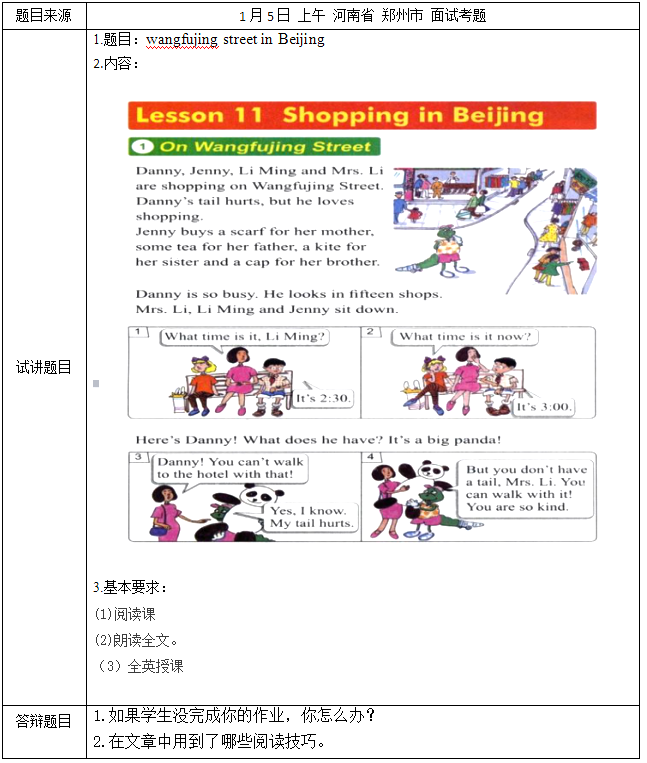
二、考题解析
【教案】
Teaching aims:
Knowledge aim:
Students can master the sentence :”what time is it? it is ..” and you can/ can not ...”
Ability aim:
Students can improve their reading skills including scanning and skimming skills
Emotional aim:
Students can be more interested in English and take part in activities.
Key and difficult point:
Key Point: know how to ask about the time and master the sentences::”what time is it? it is ..” and you can/ can not ...”
Difficult Point: use the sentence structure in daily life.
Teaching procedure:
Step 1: Warming-up
1. Greetings.
2. Ask students how did they spend their weekend.
3. Ask students “do you know wangfujing street in Beijing”
Step 2: Pre-reading
1. show a picture about wangfujing street and ask “what can you see in this picture”
2. draw a clock and ask students “Do you know how to ask about time?” and “what can you do at this time?
Step 3: While-reading
Global reading: Ask students :”how many characters in the dialogue?” and “where are they”
Detailed reading: what does Jenny buy and who will get the gift?

Step4: Post-reading
1. Role-play: two students in a group. One student act as traveller and one student is tour guide. Give them 5 minutes to make dialogue with what we have learnt today.
Step5: Summary and Homework
Summary: ask a student to conclude the content of the lesson and summarize with the whole class.
Homework: ask students to practice the sentence structure learned today with desk mates after class.
Blackboard design:
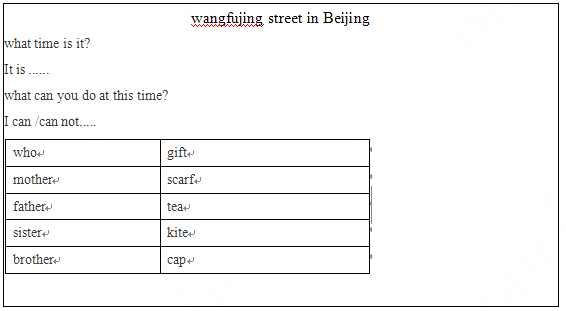
1. What will you do if the students don't finish your homework?
2. What reading skills are used in the passage?
相似考题
参考答案和解析
Homework is an important means to show students' intelligence and improve their quality. Doing homework is the summary and consolidation of the knowledge learned, so doing homework is one of the important means for students to master knowledge.Third, fourth grade students such as not to assign homework is not conducive to the timely review of students to consolidate the knowledge, is not conducive to students to develop good learning habits. Therefore, how to help students homework on time with high quality is the primary task of every teacher.
firstly, I will talk to students to analyze the reason why he did not finish the homework. The reason maybe as follows: He dose not how to do it without any help. or he thinks homework is so much and can not finish it and so on. Then I will take action according to the reasons.
2.
In order to make students be more interested in reading and can understand the knowledge clearly, I use detailed reading to make students find the detail information and global reading to find the how many characters in the dialogue. In the reading passage. students can master and scanning skills and skimming skills. They can understand the passage step by step.
更多“小学英语?阅读 ”相关问题
-
第1题:
英语四六级通过以后是不是就可以做小学英语教师呢
要看你想在哪个城市从教,是公立学校还是私立还是培训学校,不过我想你说的应该是公立吧,呵呵,还有是在城市里还是郊区还是农村,各个区域的要求肯定是不一样的。你也知道,市区的要求肯定是最高的,据我所知哈,市区的公招,小学呢,要求必须是英语专业的,,郊区我不太清楚哈,估计也差不多,只不过英语水平要求可能没市区那么高。要求低点的就是那种一村一大的了,我有同学学语文的,去叫数学,学物理的教语文,反正不是本专业的,你分去的那个学校缺啥老师,就可能就教啥。
其四,如果是私立学校的小学教师的话,口语好,过四六级,再有个教师资格证,还是有可能哈,如果再有点关系,那就太安逸了。呵呵
其五,如果去培训学校的话,过了四级,口语好,能带动课堂气氛,就OK了,有没有教师资格证都没关系的。 -
第2题:
英语教师如何控制英语阅读教学中生词量和语法的难易度?答案:解析:阅读教学和词汇量以及语法的难以程度是紧密相连的,因此教师应该了解相关背景知识,掌握阅读的教学方法,才能更好地指导学生进行阅读的学习。 -
第3题:
Ⅱ.某乡镇中学有100名初一学生,他们先前所在小学均未开设英语。现拟对其进行 一项题为“多媒体教学对初一学生英语阅读成绩影响的研究”的真实验。
请问:
最好选用哪种实验设计(写出其名称和格式)?为什么?答案:解析:
理由:这100名学生在小学里均未学过英语,无法进行前测;根据题意只能用真实 验设计,而不能用前实验设计和准实验设计。 -
第4题:
Ⅱ.某乡镇中学有100名初一学生,他们先前所在小学均未开设英语。现拟对其进行 一项题为“多媒体教学对初一学生英语阅读成绩影响的研究”的真实验。
请问:
如何产生实验班和控制班?答案:解析:可以采用等组法中的“随机分派”方式,将100名学生分成品质均等的两个班; 以抽签的方式决定实验班和控制班。 -
第5题:
小学英语阅读
一、考题回顾
 答案:解析:二、考题解析
答案:解析:二、考题解析
【教案】
Teaching aims:
Knowledge aim: Students will understand the story and know the meaning of “pull...out of” and “be stuck in”.
Ability aim: Students can be able to collect the main idea and the details.
Emotional aim: Students will develop the interest in learning English.
Teaching key and difficult points:
Key point: Students will know the meaning of “pull...out of” and “be stuck in”.
Students can be able to collect the main idea and the details.
Difficult point: Students will develop the interest in learning English.
Teaching Aids:
Teaching procedures:
Step 1: Warming-up
1. Greeting: Ask “how are you today?”.
2. Sing a song named Little Ant for students
The ants go marching one by one, hurrah,hurrah!
The ants go marching two by two, hurrah,hurrah!
The ants go marching three by three.
The little one stops to climb a tree.
And they all go marching down to the ground
To get out of the rain,
BOOM! BOOM! BOOM!
Ask them “are you happy now?” and “ do you find some ants in this song?”. Then tell them we will learn a small interesting story about the ant.
Step 2: Pre-reading
1. Briefly explain the meaning of “pull...out of” and “ be stuck in” with pictures.
Step 3: While-reading
1. Ask students to read the short story for the first time. After that, ask them to tell me what the main idea of the story is.
2. Ask students to read it for the second time. This time, students need to find what the weather is like today and the next day.
3. Let them read it for the third time, and answer the questions: how they feel and what’s wrong with them?
Step 4: Post-reading
Ask students to work in a group of four, and try to retell the short story in their own words according to the clues on the black board.
Step 5: Summary and homework
Summary: Conclude the content of the lesson and summarize with whole class.
Homework: Think about what will happen to them in the third day, share with us next lesson.
Blackboard design:

【答辩题目解析】
1.Do you think it is important to teach students the phenomenon or not?
【参考答案】
I think it is very important. There are several reasons as following. First, some knowledge is too abstract or general to understand. Teaching the phenomenon to students can help them quickly understand what they are learning. Second, after doing that, students can remember the knowledge according to the logic or other aspects, which is conducive to consolidating and memorizing the knowledge they have learned as solid as possible.
【答辩题目解析】
2.How to improve students speaking ability?
【参考答案】
First, the teacher should create a relaxing learning atmosphere and stimulate students’ learning interest. Introducing activities, such as games and competitions that students like into the classroom can fully mobilize the enthusiasm of students, and turn "speaking English" into a pleasant experience. Second, the teacher also needs to create the real situation. Their interest can be inspired in the process of using in the situation. Third, the teacher needs to strengthen oral training with various forms, such as role-play, telling a story. -
第6题:
认真阅读下列材料,并按要求作答。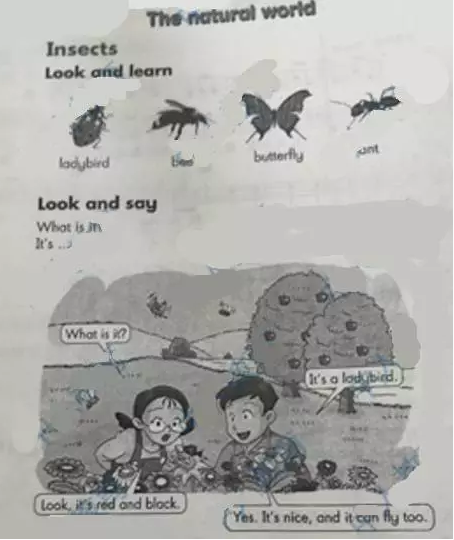
根据上述材料完成下列任务:
(1)简述英语儿歌的特点
(2)如指导小学生学习,试拟定教学目标。
(3)依据拟定的教学目标,设计导入和操练环节的教学活动并说明理由。答案:解析:【参考答案】
(1)①用词简单,易于理解
儿歌所适用的对象决定了其语言必须简单明了,易于儿童接受和理解。
②句式多样,结构灵活
英语儿歌每个诗节的长度从两行到八行不等,有时甚至出现更长的诗节,因此可以呈现在不同的场合,产生不同的效果,从而吸引儿童,使其兴致浓厚,爱不绝口。
③韵律响亮,朗朗上口
儿歌的英文名称为nursery rhyme,由此可得出押韵(rhyme)是其必要条件之一,同样英语儿歌的韵律格式多样。
④语言活泼,生动形象
英语儿歌中可以见到运用各种修辞格的实例,其中,比喻、借代、拟人等比比皆是。
(2)Teaching Aims:
Knowledge aims:Students canmemorize the new words”ladybird,bee,butterfly,ant”and master the usage of thesentence “What’s it? It is...”
Ability aims:Students can ask andanswer with the sentence patterns “What’s it? It is...”
Emotional aims:Students will lovenature,and their interest in learning English will be stimulated.
(3)导入环节(Lead-in):
①Rhyme:Play a rhyme of A farmer and ten chicks.
②Daily talk:Can you tell me what insect do you like ?
【设计理由】播放节奏感强的儿歌,可以活跃课堂气氛,激发学生的学习兴趣,同时可以引出本课的话题。小对话可以帮助学生复习以前学习过的昆虫的名字,为导入新课做准备。
操练环节(Practice):
Activity 1:Guessing game
Play a game with students— “which one ismissing?”
The teacher will show the words of“ladybird,bee,butterfly,ant”on the blackboard and cover one word then askstudents “which one is missing?” Students will guess the word and then theteacher will show a picture of forest with many insects and cover one pictureof a insect and ask student “which one is missing?”
【设计理由】通过猜单词的游戏,可以帮助学生巩固本课所学习的单词,通过猜图片说英语,可以帮助学生更形象地理解单词的含义,更易于记忆。
Activity 2:Pair work
The teacher will show a video clip of agarden with many insects ,And ask students to introduce the insects in pairs.And then ask them to show their introductions to whole class. Students shoulduse the sentence patterns of “What is it ? It is...”
【设计理由】角色扮演的活动,可以巩固本文学习的句型,并帮助学生提升口语表达能力。 -
第7题:
信息技术整合于英语阅读教学的优势不包括()
- A、提供广泛的英语阅读学习资源
- B、提供支持学生进行阅读实践活动的工具
- C、交流方式单一
- D、提供各种学习策略
正确答案:C -
第8题:
教幼儿学英语应当从培养幼儿的()能力开始。
- A、英语倾听
- B、英语表述
- C、英语阅读
- D、英语书写
正确答案:A -
第9题:
全美英语教师协会和国际阅读协会主持制定的《美国英语课程标准》被视为“国家标准”。
正确答案:正确 -
第10题:
《英语课程标准》规定,从()起开设英语课程。
- A、小学一年级
- B、小学二年级
- C、小学三年级
- D、初中一年级
正确答案:C -
第11题:
单选题信息技术整合于英语阅读教学的优势不包括()A提供广泛的英语阅读学习资源
B提供支持学生进行阅读实践活动的工具
C交流方式单一
D提供各种学习策略
正确答案: B解析: 暂无解析 -
第12题:
判断题英语阅读和汉语阅读不一样,它不会涉及语音解码。A对
B错
正确答案: 错解析: 暂无解析 -
第13题:
英语四级阅读有几篇?
读理解可以说有三篇的,另有一篇在阅读部分,但它是选词填空。试卷排序:写作,一篇阅读理解,听力,选词填空,两篇阅读理解,完形填空,翻译。
-
第14题:

问题:以上是某小学英语教师为“We love animals”一课所设计的教案。请阅读并点评该教案,分析指出其优点与不足。(请用中文作答)(10分)答案:解析:(1)优点 ①通过歌曲,自然导入本节课的学习,激发学生的学习兴趣。
②组织游戏,对所学新知进行巩固,将图片与单词联系起来,使学生对单词的记忆更准确。进行结对活动,学生之间进行互动,照顾到了全体学生的学习,体现了面向全体学生的活动设计原则。
③运用PPT和音频进行教学,以多种方式呈现新知,提高了学生的学习效率。
(2)缺点
①缺少教学目标和教学重难点,整节课的目的不够明确。
②小学生注意力持续时间短,稳定性差,而在呈现环节中,以教师为主导,进行填鸭式教学,没有充分发挥学生的主体作用。
③在练习环节,活动设计多为语言操练,缺乏产出性活动,不利于学生语言运用能力的培养。 -
第15题:
Ⅱ.某乡镇中学有100名初一学生,他们先前所在小学均未开设英语。现拟对其进行 一项题为“多媒体教学对初一学生英语阅读成绩影响的研究”的真实验。
请问:
这样设计有何优缺点?答案:解析:优点:由于进行了等组化处理,且不存在前测对后测的影响,同时这种实验能系统操纵自变量并有效控制无关变量,所以内在效度较高;不进行前测,也适合学生的 实际情况。
缺点:个别学生有可能自学过英语,由于没有前测,这一情况带来的差异不易发现。
【评分说明】若有其他合理答案,可酌情给分。 -
第16题:
小学英语 语音
一、考题回顾
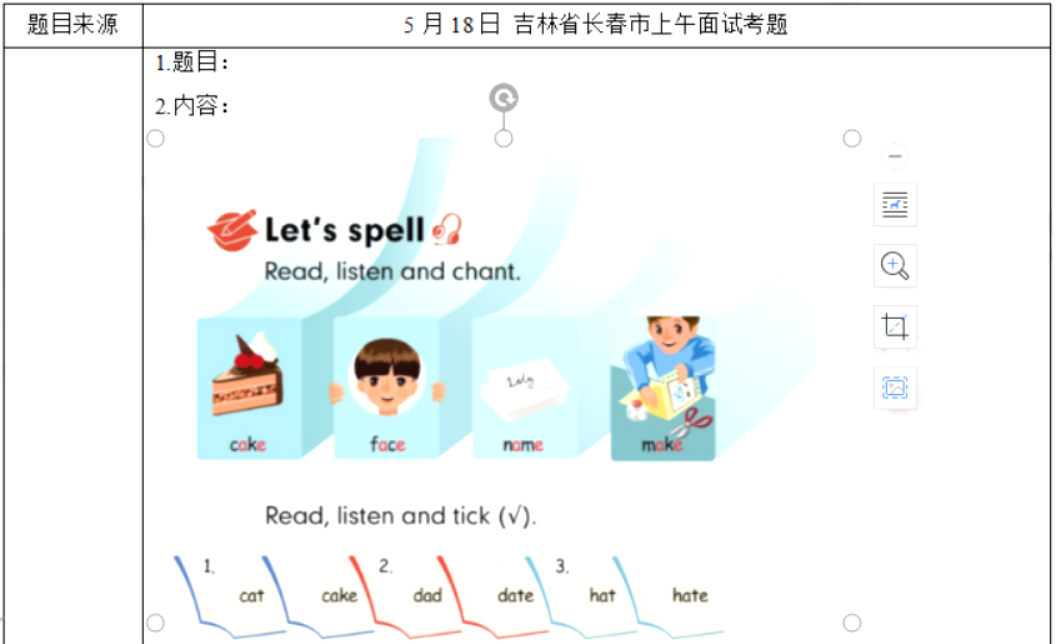

 答案:解析:二、考题解析
答案:解析:二、考题解析
【教案】
Teaching aims:
Knowledge aim:
Students will master the pronunciation of the letter “a”.
Ability aim:
Students will know how to pronounce “a” in words.
Emotional aim:
Students will be interested in learning English after the class.
Key and difficult point:
Key Point:
Students will master the pronunciation rules of the letter “a”.
Students will know how to pronounce “a” in words.
Difficult Point:
How to arouse students’ interest of learning English.
Teaching procedure:
Step 1: Warming-up
1. Greetings. Talk about the weather.
2. Sing a song with the students
Apple round apple red
apple juice apple sweet
apple apple I love you
apple sweet I love to eat
Ask them what fruit is this song mentioned. They may say “apple”. Then tell them that today we are going to learn the pronunciation of letter “a”.
Step 2: Presentation
1. Show some pictures according to the aim words , and then explain the meanings to the students.
2. Play the finger show with the students to consolidate the words. For example, finger 1 refers to “cake”, and finger 2 refers to “face”. When the teacher points finger 1, the students should read “cake” loudly. The rest could be done in the same manner.
3. Ask students to find similarities among the words. They may say that in these words, there is “a” in the words.
4. Conclude the rules of “a”. Tell them that when they see “a” in the structure a_e of a word , they should pronounce [ei].
Step 3: Practice
1. Play a game named “High and low voice”.
2. Ask students to finish the exercise “Read, listen and tick ” on the book, then ask some students to share the answer.
Step4: Production
Ask students to make a chant with their deskmates using the words we learned today. 5 minutes will be given. After that, invite one pair to share their chant. Give encouragement.
Cake cake make a cake
Face face make a face
Name name make a name
Step5: Summary and Homework
Summary: Ask a student to conclude the content of the lesson and summarize with the whole class.
Homework: Read the words and chant to their parents.
Blackboard design:
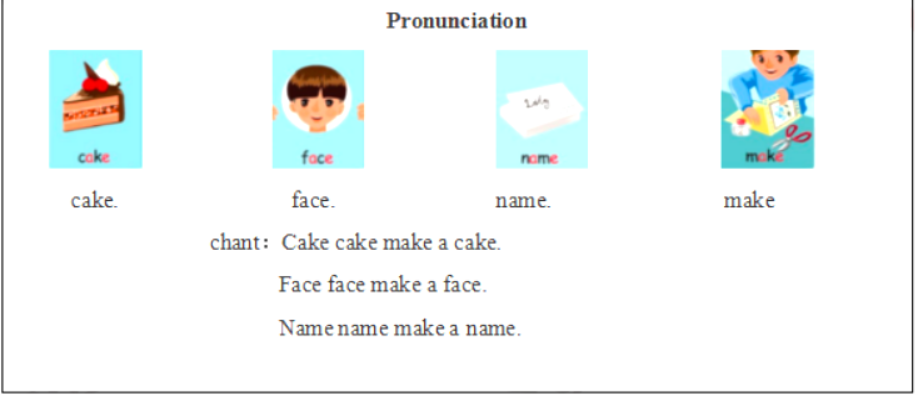
【答辩题目解析】
1.How to make a nice atmosphere for primary school students?
【参考答案】
A happy and nice atmosphere is very important for primary school students. So in the class, I will arrange some games and activities for students, providing them more chances to act and play, lead them to study in all kinds of games and activities.
【答辩题目解析】
2.Can you swim?
【参考答案】
Well, I can’t swim, but I know swimming is a very good sport for us. It can make us strong and happy. So I will spare some time to practice and learn to swim. I think if I can learn to swim, I can also do other things better in my daily life. -
第17题:
小学英语语音
 答案:解析:
答案:解析:
Put your ear, near my ear,
put your ear, near my ear,
and you will hear, and you will hear,
and you will hear,
NOTHING!
Ask them “are you happy now?” and lead them to circle out some words they learned last lesson. They may point out “ear”, “near”, “ hear”. Then tell them we will learn the pronunciation secret of these words.
Step 2: Presentation
1. Show some pictures based on these target words, and briefly explain them for students.
2. Ask students to look at them carefully and try to find the same part of these words. They may say there is the letter group “ear” in the words.
3. Conclude the pronunciation rule of “ear”. Tell them that when they see “ear” in a word, in most cases, they sound same. Also I will remind them the right pronunciation again. And ask them to read the letter group “ear” and the words three times.
Step 3: Practice
1. Play the game named Hot Potato with students to consolidate the pronunciation of “ear”. when I sing, students will pass a pencil one by one. When I stop, the one who gets the pencil needs to read the letter group “ear” and the word I point out.
2. Ask students to pick up other words that share the letter group “ear” as much as possible.
Step 4: Production
Show a tongue twister on the screen. And read twice for students. Ask them to give a performance in front the class five minutes later. Give encouragement.
I shed tears for he shears my dear toy deer’s ear.
Step 5: Summary and homework
Summary: Conclude the content of the lesson and summarize with whole class.
Homework: let their parents to make a small video of their chant o1r tongue twister performance.
Blackboard design:

【答辩题目解析】
1.Do you think vocabulary teaching is essential, yes or not?
【参考答案】
Yes, I think vocabulary teaching is essential. Vocabulary is the base of language. Without sufficient vocabulary, we can't effectively speak, read, and write, and can't communicate effectively in English as well. Mastering enough vocabulary is the key to successful use of foreign languages.
【答辩题目解析】
2.Why do you want to be an English teacher?
【参考答案】
First, I love English very much. Every time I am reading English aloud,I feel I was singing the most beautiful song. Second, Teacher is one of the most respectable jobs though it is not very profitable.I feel very good to be a teacher.I can help my students figure out their questions and improve their English.There is a kind of accomplishment here,you know.Third,I love to hang around the campus because the atmosphere here is very pure and honest.I love being with teachers and students.They are all so kind. -
第18题:
请认真阅读下列材料,并按要求作答。
请根据上述材料完成下列任务:
(1)简述在小学英语教学中应如何使用多媒体。
(2)如指导小学生学习材料,试拟定教学目标。
(3)依据拟定的教学目标,设计导入环节和新知呈现环节的教学活动并说明理由。答案:解析:(1)小学英语教学中使用多媒体的方法 ①巧用多媒体,激发学生的学习兴趣。
②巧用多媒体,创设情境,引入新课。
③巧用多媒体,活化教材,寓学于乐。
④巧用多媒体,提高利用时间的效率。
⑤利用网络技术,扩展学生的知识面。
(2) Teaching Aims
Knowledge aim: Students will be able to learn and master the structure to describe animals.
Ability aim: Students can make sentences through imitation of the example. Their abilities of making sentencescan be improved.
Emotional aim: Students will get more interest in learning English and in protecting animals.
(3)导入环节和新知呈现环节
Lead—in(导入环节):
①Show the video about different kinds of cats. Ask students some questions:
Q1: What can you see in the video
Q2: Which kind of pet do you like best
②Free talk.
Ask some questions about pet, for example:
Q1: Have you ever kept a pet
Q2: How does it like
Q3: What color is it
Q4: When is its birthday
【设计意图1
视频和讨论的目的是为了吸引学生的注意力,同时明确本课的话题。
Presentation(新知呈现环节):
Show the picture about kittens.
① Show the first picture, and ask students "What's this". Students may give such answer as "They are pigs""They are mice", and so on.
② Show other pictures. Student will understand that they are kittens.
③Ask students to pay attention to the date and reorder the pictures.
Read and match.
① Show some sentences about pictures and ask students to try to match it.
Such as:
They have white fur.May 3rd.
They can walk.April 21st.
② Let students review the knowledge they learned about the date: We should put the "on" before the month.
③ Make sentences through imitation of the example "Their eyes are open on April 26th."
Invite some students to write two sentences about the kittens on the blackboard.
Ask students to make new sentences to describe the animals they like.
【设计意图】
通过图片让学生更形象地感受到小猫的变化。通过句子配对的方式,让学生学会组词造句,提升描述事物的能力。 -
第19题:
小学英语教学属于第二语言教学
正确答案:正确 -
第20题:
作为小学英语教师,你认为如何给小学生上好英语课?
正确答案: 小学生的年龄一般是六至十二岁,属于童年期,正处于心理发展变化的关键时期。在这一时期,儿童的心理变化和大脑思维最活跃。根据儿童时期的特点,我认为在小学英语课上应该做好以下几点:
1.重视持续培养和激发学生学习英语的浓厚兴趣。
在英语教学过程中,要把握好小学生的初步兴趣,这种初步兴趣就是学生在开始学习英语时有一种很强的好奇心,而这种初步兴趣是极不稳定的。作为教师要使学生对学习英语的兴趣持续下去,并升华为热情和爱好,就要在教学活动中下工夫,要懂得童年期的心理特征,要懂得小学生对学习英语的兴趣主要不是来源于英语语言本身,更多的则是来自于英语教学活动的形式。如果教师所设计的教学形式不符合小学生的认知规律和心理特征,那么,学生对英语学习的初步兴趣就会丧失殆尽,更谈不上对英语的热情和爱好了。
2.在教学活动中,要有和谐的语言教学氛围。
在课堂上,教师态度和蔼,平易近人,语言里要流露出安慰和鼓励,这样才能提高学生的学习热情和树立学好英语的信心。任何训斥、讥笑和讽刺都不利于双边活动的开展,还将削弱学生学习英语的积极性。在教学活动中,教师还应该积极地关心、帮助学生,积极引导他们参加集体活动。对有困难的学生更要耐心帮助,同时鼓励他们要互相关心和帮助,使教学活动得以顺利进行。
3.要重视学生基本技能和学习习惯的培养。
在培养技能方面,教师在教学活动中不能灌输大量的语言知识,要充分利用图片、挂图、实物、幻灯、录音、录像等开展多种形式的英语游戏、学唱英语竞赛、表演、学唱英语歌曲等活动,做到寓教于乐,使学生置身于情境之中,使学生的听力、英语的口头表达能力及实际运用英语的能力得到巩固和提高。要重视英语的基础训练,从而使学生获得一些运用英语的基本技能。
在培养习惯方面,教师在开展灵活多样的教学活动的同时,要多为学生创造一些运用英语的语言环境,让学生多听、多说、敢于大胆开口,要体现出学生的主体作用,使学生养成良好的语言习惯。书写也是小学英语教学的主要内容和目的之一,从小学起教师就应当狠抓学生的书写教学,并常抓不懈。为了培养学生良好的书写习惯,教师要起到示范和身教的作用,教师自己的书写首先要做到工整和规范,这样才能做到言传身教。 -
第21题:
英语阅读和汉语阅读不一样,它不会涉及语音解码。
正确答案:错误 -
第22题:
问答题作为小学英语教师,你认为如何给小学生上好英语课?正确答案: 小学生的年龄一般是六至十二岁,属于童年期,正处于心理发展变化的关键时期。在这一时期,儿童的心理变化和大脑思维最活跃。根据儿童时期的特点,我认为在小学英语课上应该做好以下几点:
1.重视持续培养和激发学生学习英语的浓厚兴趣。
在英语教学过程中,要把握好小学生的初步兴趣,这种初步兴趣就是学生在开始学习英语时有一种很强的好奇心,而这种初步兴趣是极不稳定的。作为教师要使学生对学习英语的兴趣持续下去,并升华为热情和爱好,就要在教学活动中下工夫,要懂得童年期的心理特征,要懂得小学生对学习英语的兴趣主要不是来源于英语语言本身,更多的则是来自于英语教学活动的形式。如果教师所设计的教学形式不符合小学生的认知规律和心理特征,那么,学生对英语学习的初步兴趣就会丧失殆尽,更谈不上对英语的热情和爱好了。
2.在教学活动中,要有和谐的语言教学氛围。
在课堂上,教师态度和蔼,平易近人,语言里要流露出安慰和鼓励,这样才能提高学生的学习热情和树立学好英语的信心。任何训斥、讥笑和讽刺都不利于双边活动的开展,还将削弱学生学习英语的积极性。在教学活动中,教师还应该积极地关心、帮助学生,积极引导他们参加集体活动。对有困难的学生更要耐心帮助,同时鼓励他们要互相关心和帮助,使教学活动得以顺利进行。
3.要重视学生基本技能和学习习惯的培养。
在培养技能方面,教师在教学活动中不能灌输大量的语言知识,要充分利用图片、挂图、实物、幻灯、录音、录像等开展多种形式的英语游戏、学唱英语竞赛、表演、学唱英语歌曲等活动,做到寓教于乐,使学生置身于情境之中,使学生的听力、英语的口头表达能力及实际运用英语的能力得到巩固和提高。要重视英语的基础训练,从而使学生获得一些运用英语的基本技能。
在培养习惯方面,教师在开展灵活多样的教学活动的同时,要多为学生创造一些运用英语的语言环境,让学生多听、多说、敢于大胆开口,要体现出学生的主体作用,使学生养成良好的语言习惯。书写也是小学英语教学的主要内容和目的之一,从小学起教师就应当狠抓学生的书写教学,并常抓不懈。为了培养学生良好的书写习惯,教师要起到示范和身教的作用,教师自己的书写首先要做到工整和规范,这样才能做到言传身教。解析: 暂无解析 -
第23题:
单选题《英语课程标准》规定,从()起开设英语课程。A小学一年级
B小学二年级
C小学三年级
D初中一年级
正确答案: B解析: 暂无解析 -
第24题:
单选题教幼儿学英语应当从培养幼儿的()能力开始。A英语倾听
B英语表述
C英语阅读
D英语书写
正确答案: B解析: 暂无解析
